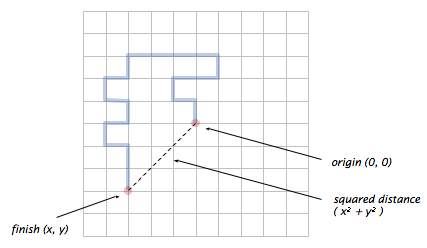Remark: This computes the number of bits in the binary representation of N, which also equals 1 + floor(log2 N) when N is positive. This quantity arises in information theory and the analysis of algorithms.
% java Checkerboard 4 % java Checkerboard 5 * * * * * * * * * * * * * * * * * * * * * * * * * * * * * * * * * * * * * * * * *

-
Write a program RandomWalker.java that takes a command-line
argument N and simulates the motion of a random walker for N
steps. After each step, print the location of the random walker, treating
the lamp post as the origin (0, 0).
Also, print the square of the distance from the origin.
% java RandomWalker 10 % java RandomWalker 20 (0, 0) (0, 0) (0, -1) (0, 1) (0, 0) (-1, 1) (0, 1) (-1, 2) (0, 2) (0, 2) (-1, 2) (1, 2) (-2, 2) (1, 3) (-2, 1) (0, 3) (-1, 1) (-1, 3) (-2, 1) (-2, 3) (-3, 1) (-3, 3) squared distance = 10 (-3, 2) (-4, 2) (-4, 1) (-3, 1) (-3, 0) (-4, 0) (-4, -1) (-3, -1) (-3, -2) (-3, -3) squared distance = 18 -
Write a program RandomWalkers.java that takes two
command-line arguments N and T.
In each of T independent experiments,
simulate a random walk of N steps and compute the squared distance.
Output the mean squared distance (the average of the T squared distances).
% java RandomWalkers 100 100000 % java RandomWalkers 400 100000 mean squared distance = 100.15086 mean squared distance = 401.22024 % java RandomWalkers 100 100000 % java RandomWalkers 800 100000 mean squared distance = 99.95274 mean squared distance = 797.5106 % java RandomWalkers 200 100000 % java RandomWalkers 1600 100000 mean squared distance = 199.57664 mean squared distance = 1600.13064
- As N increases, we expect the random walker to end up further and further away from the origin. But how much further? Use RandomWalkers to formualte a hypothesis as to how the mean squared distance grows as a function of N. Use T = 100,000 trials to get a sufficiently accurate estimate.
Remark: this process is a discrete version of a natural phenomenon known as Brownian motion. It serves as a scientific model for an astonishing range of physical processes from the dispersion of ink flowing in water, to the formation of polymer chains in chemistry, to cascades of neurons firing in the brain.
Remark: a classic result from probability theory asserts that the shape of the resulting histogram is well-approximated by the ubiquitous bell curve (Gaussian distribution).